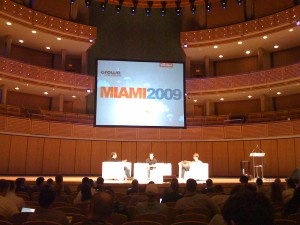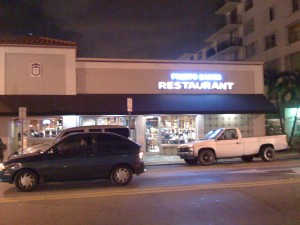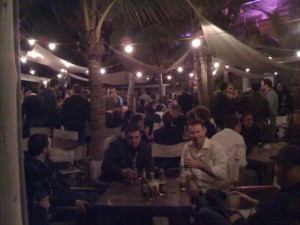That was the motto of Ryan Carson this past week at the Future Of Web Apps conference in Miami, Florida. As a first-time and slightly skeptical attendee of this event, I can now happily affirm that I am indeed all three.
I had a pretty good feeling about things the moment I landed in the midst of pristine weather on Sunday evening. My hotel, which I chose seemingly at random, was situated a stone’s throw from South Beach. But the room itself was distinctly lacking in frills—an unassuming king-sized mattress bore the weight of my imminent slumber, and a clunky television relayed lackluster imagery from a limited supply of channels. I half expected Max Headroom to show up on this war-torn monitor, but before he had the chance, I was out cold. The operative word here is “cold,” for I awoke a bit earlier the next morning than I would have liked, thanks to the icy air flowing freely beneath my sheets. Next stop: free breakfast in the lobby.

The impressive stage of the main conference
I have to say that the bagel and cream cheese were exemplary, though the same cannot be said of the coffee. Soon enough I called for a cab to take me to the main venue, and whilst waiting met Baltimore’s own Javie Rios, a web designer who, I discovered, shall attempt to represent the U.S. in the 800 metres at the next Summer Olympiad. We arrived at the Adrienne Arsht Center and began our first of two workshops for the day. I really had no clue which of these workshops I would be attending, but eventually ended up at the one concerning the Social Web, specifically the paradigms of OpenID, OAuth, and Activity Streams, among others. This proved quite valuable for me, a bemused veteran of the current OpenID system, a noble concept that is racked with irritations. But I greatly enjoyed hearing David and Chris explain where they’ve been and where they’re going—how such stalwarts as Google, Yahoo, and now Facebook are all on board with this emerging system of ubiquitous user management, and how it will one day be much easier for all of us to log in and share information easily between all of our websites and services. The standard interface for logging onto sites using OpenID has been admirably refined, although pop-ups are still favored over AJAX boxes so that the user knows precisely which URL is asking for his password. An idea that popped into my head at this time was that no source is more trusted than the browser itself, so I would love to see OpenID login integrated with the major web browsers as soon as possible. The ideal scenario for OpenID would certainly make life vastly easier for both users and developers on the web.
At this point the conference attendees were rewarded with a yummy box lunch featuring a sandwich wrap and other trinkets. During the break, I met Sam Thomsen, a .NET developer from Denmark who, along with his coworkers, had parlayed his visit to Miami into a full-blown vacation. Good call, huh? I then ran into Nikki Scoggins, a sprightly gal who works for Vans and is responsible for their various social media efforts. In the midst of our discussion, a friendly gent by the name of Ryan plopped down beside us and expressed his keen interest in the Vans brand, himself wearing a distinctive green pair from the venerable shoemaker. Only after a couple of minutes did I realize that this Ryan was the selfsame Carson who is responsible for the entire event, so I credit that to his approachable and friendly nature (and a bit to my own obliviousness). I was able to talk to him a little about my employer Merge, and how I left in the midst of a site launch to be here, a fact he duly appreciated.
Now it was time for workshop number two, a presentation from Wufoo‘s Kevin Hale about how to convert free customers to paying customers on our web applications. A few things stood out to me here. One: display all paid functionality on each page, even to free customers. People won’t buy it if they’re not aware of it. Two: try to stay away from coupon codes. Studies show that people will abandon their shopping carts when they see a coupon code box, because it clearly shows that they could be getting a better deal—those shoppers may leave to find a code but won’t return if they don’t find one. Additionally this workshop also provided a good synopsis of analytics tools like Crazy Egg and ClickTale that can effectively show how visitors are using your site. And perhaps most enlightening was the comparison of the relationship between your business and your customers to the marriage relationship, specifically the theories of Dr. John Gottman and how you can greatly enhance your company’s reputation by engaging in open and honest communication with your users, a strategy employed with great success by Zappos.
Day one’s official events had drawn to a close, but there was more to be done. In the Arsht Center lobby, I met Romain, a web developer from France who has worked on a pretty nifty app that lets his customers provide precise feedback by clicking on specific areas of a screenshot and leaving relevant comments. I spent a fair amount of time with Romain and really enjoyed discussing the differences between our countries and the challenges of working for a small business that are specific to each. (Special note to Burger King: you are greatly missed in Paris and would be welcomed back with open arms.) Before heading back to my hotel, I joined Javie, Romain, and Avin for some quality grub at Mike’s at Venetia—I devoured my “dolphin sandwich” with a true sense of purpose. We enjoyed an hour or two of excellent conversation, capped by my request for some bands that I should be listening to (American Head Charge, Switchfoot, and The Used, apparently). My suggestion for them? Plaid’s Double Figure.
I was definitely ready for sleep, and sleep I did. But the next morning, things would take a turn for the weird. My room phone rang a little after 7:00 in the morning, a half hour before my alarm was set to go off. I ignored it, but then it rang again. Bemused and confused, I answered. “Hello, sir,” said the lady at the front desk. “I’m sorry to bother you, but the gentleman next door to you needs to get into his room, and his door lock malfunctioned. Would you mind if we came through the connecting door in your room?” Before I had a chance to consider that opening his connecting door from my side might prove just as challenging as opening his main door without a key, I agreed. Within minutes, the woman and the guy in question, both likely in their twenties, entered the room and began discussing the situation in Spanish. As I stood beside my bed with mussed hair, raggedy shirt, sweatpants, and doubtless a face betraying extreme befuddlement, the guy opened my connecting door then proceeded to launch a full shoulder charge into his connecting door. He repeated this about twelve times, with brief interruptions punctuated by additional Spanish dialogue. Eventually the door cracked then burst open, presumably solving the immediate problem but creating a new one for future concern. Now that I was fully awake, I showered, dressed, and went downstairs to enjoy another scrumptious bagel.

Puerto Sagua = Best. Cuban Food. Ever.
Javie and I caught a taxi again and arrived for the start of the main conference itself. The auditorium was impressive, and the audience was eager for the show to start. Ryan came on stage for a brief intro, and before long we had our first speaker, Jason Fried of 37signals. Jason has a penchant for making controversial statements on his company’s blog, and while I disagree with him about half the time, I appreciate his willingness to take a stand on things. His major point during his speech was that web developers should stop giving away our work for free. Open source software is a popular movement, and it’s not going anywhere, but just because a big company like Google or Mozilla can give away stuff for free doesn’t mean the rest of us should necessarily follow suit. Even if our direct competition is open source, the market is still big enough for companies that charge—there are plenty of customers for everyone. Also we should look for opportunities to sell our “byproducts.” In the case of 37signals, these take the form of knowledge shared in books and conferences, each with price tags attached.
Next up were Ben and Dion, a couple of guys from Mozilla who talked about the future of the web browser. They discussed a quartet of exciting features, some of which are already in place for many browsers: Canvas, fast Javascript, web workers, and desktop integration. Following them was Dan from Yahoo Developer Network, who discussed such technologies as the YUI library and YSlow, the latter tool which I have consistently found very useful. We were then dismissed for a lunch break, so after a quick trip to Burger King, I returned to the facility and crossed paths with the lovely Jeile Marie, host of Go Live Miami, a series of fun webisodes about the plethora of events in the area. Jeile had actually come by our table the previous night at Mike’s and told us a little bit about her site, so I enjoyed the chance to have a longer discussion about the event and our respective backgrounds. I’m still cracking up as I think of the “Hot Lips” shirt she was wearing. Hopefully I was able to give her a few good pointers as she continues her video projects. (Hint: start networking with iJustine if possible!)
The next wave of speakers began with Joe Stump from Digg, who had some nice ideas about how to construct development teams—holding them to under 10 people is a start, but of course you can have multiple teams. He also implored us to use version control if we are not already. I myself have used Subversion in the past but would love to start using Bazaar at Merge. Also heavily endorsed was the concept of unit testing, a bridge I have yet to cross but am sure to encounter at some point. Next on stage was Kristina from Brain Traffic, who expounded the importance of good web copy then initiated a discussion about the still lackluster presence of women at web conferences. She had a good attitude about the matter, but all agreed that it will take continued effort to get more female voices on stage. Really though, this is a problem that has been a part of all computer science industries since day one. There may be something more physiological at play here that none of us fully understands yet.
Aza from Mozilla was our next presenter, who talked about the “chaordic” workflow (ordered chaos) that drives innovation at Mozilla. He identified five directions the web browser space could take in the next five years: people will become more important than technology, common tasks will become more ambient/low-cost, the browsing experience will become more continuous between desktop and mobile, tabs will graduate to a more user-friendly “2.0” interface, and functionality will be customizable by the use of technologies like Ubiquity. Our next speaker was Dave Morin from Facebook, who touched on Facebook Connect and outlined three features of the social web moving forward: identity (give users control and trust), friends (give users the power to connect with each other), and feed integration (promote openness in your web applications).
What happened next could be classified as the obligatory dud of the conference, and appropriately enough the hapless Microsoft found themselves at the center. The company put on some sort of web app design challenge about space travel called Phizzpop, and we the audience witnessed the presentations of the two finalists. The first was a group apparently comprised of college students, with the peculiar brand of awkwardness that can be expected from this age group. Still, they achieved more success than the second group, which was made up of what might be considered the stereotypical programmer types. There’s really no need to say too much more about this contest, because none of us really knew what was going on or why it was happening. But a hearty congratulations to group one for emerging victorious.
Joel Spolsky then took the stage and delivered a somewhat dry and wry speech about “development team nirvana” and how his company has structured its office space to promote this goal. The key elements of this initiative were separate offices for each programmer, snacks always within a close radius, and ample money spent on proper chairs. Team lunch outings were also heavily endorsed, so it’s nice to know that Merge is doing its part to help me achieve self-actualization. Next up was Dave McClure, who was not afraid to perpetrate garish fonts and colors on the audience in order to make his point about how to grow and maintain your user base: acquisition, activation, retention, referral, and revenue. Concentrate on executing your plan in that order, and you too will find multicolored success… or something. Rounding out this portion of the lineup was Alex from Virgin, a company with a truly distracting name that yet manages to plaster it on every conceivable type of product. Needless to say, this presentation was about the importance of your brand. Key point: in the age of the web and social media, more people than ever are equipped with B.S. detectors (and I think mine may have started going off).

The Nikki Beach after-party. Good times.
Okay, only two speakers left, and by all accounts they were the stars of the show. First, the initially unassuming Francisco began talking about his company 280 North but in no time flat was bringing the house down in uproarious applause. The reason? Atlas, a graphical IDE front-end for Cappuccino that allegedly allows developers to construct layouts and incorporate logic for instantly cross-platform web applications, potentially alleviating developer frustration with tweaking apps for IE and iPhone. The demo was admittedly impressive, and I for one wish them nothing but luck in bringing it to fruition. I asked Francisco later about back-end database support, and he indicated they would be aiming to ship Atlas with some built-in database management, but it’s still unclear right now how much code the developer will be required to write by hand to hook into, for example, existing MySQL tables.
The last man to take the stage was someone whom I had only seen previously on Late Night with Conan O’Brien as a whacked-out “wine expert” who wanted Conan to eat dirt and other miscellany in order to develop his palate. Yes, friends, I speak of Gary V. Apparently he also has a thing or three to say about making your mark in your chosen industry and taking advantage of trends and opportunities in business. His basic advice is to hustle (or more creatively, “crush it”) if you want to succeed. “Passion is undefeated,” he says, and with this I agree. He said several other things, and said them as colorfully as possible, so if you’re ready for an aural assault, feel free to check out his pep talk for yourself.
Whew. I certainly was not alone in feeling like I had just absorbed a heapin’ helpin’ of quality information that would last me for another year, so the rest of the evening was dedicated to relaxation and fraternizing. Romain and I walked over to the bus station, where we combined forces with Nikki (with whom I might have the opportunity to collaborate on a project—stay tuned) and our new friend Victor from Philly. When we got back to South Beach, I discovered that Victor had a significantly superior hotel room despite paying a similar rate. Sure, it was a little farther from the major clubs and such, but it had a widescreen TV and a box full of assorted sweets and treats! Anyway, whilst Victor met up with another friend, the remaining three of us ate at a wondrous Cuban cafe named Puerto Sagua, where I feasted on a mixture of Spanish ground beef and rice, with black beans and fried plantains on the side. This meal was approximately 100 times better than my sole previous Cuban dining experience, and I would recommend it to anyone visiting Miami Beach.
From here we eventually made our way to the official FOWA after-party at Nikki Beach, a place which I’m fairly certain would possess a slightly different atmosphere on nights when a swarm of web developers have not descended upon it. I say this because I had been informed earlier by Jeile that their standard dress code falls squarely into the category of posh. Speaking of Jeile, we were able to meet up again here, and she kindly expressed her gratitude for my helping her get the lowdown earlier in the day about the conference happenings to that point. We talked a little more about the stuff she was shooting for the event, and I helped her track down Jason Fried for an interview. I do believe the resulting video is now online at Go Live Miami, so enjoy! Meanwhile Romain and I started a table that progressively grew in size so that it eventually resembled a giant poker game. Thanks to to Nik and Chris from Enso CMS, Avin and his wife, and everyone else who dropped by the best table at Nikki Beach!

Couldn't complain about this
Luckily my flight out of Miami the next day was scheduled for the afternoon, so I was able to spend a lazy Wednesday morning walking up South Beach and savoring the cool 71-degree temperature and sunny skies. As I paced barefoot through the sand and the water’s edge, I began to notice a particular feature of the beach that I had not anticipated. Indeed I speak of topless sunbathing, an activity enjoyed by no less than four participants during my roughly 45 minutes spent patrolling the area. It must be pointed out that each of these women was equipped with surgically enhanced wares that she was probably eager to showcase for others, and given the price tag of these acquisitions, such motives are understandable. Still, I think the ladies of the world may benefit from the observation that most guys, myself included, would prefer your natural beauty unretouched by scalpels and silicone.
At last it was time for me to leave this vacationer’s paradise, to bid Miami and its beaches and its hot pink signage adieu. Romain and I caught a cab back to the airport, ate some deliciously greasy American pizza, and lounged at the terminal until my flight was ready to board. I took my seat on the plane, broke open my recently purchased copy of Dante’s Inferno, and was impressed by a few recurrent themes from the conference. Fellow developers and entrepreneurs, I leave you with the words of Dante’s Virgil:
What is it, then? Why stand here, why delay?
Why let such cowardice come take your heart?
Why are you not afire and bold and free?
And Dante’s response:
Your words have put my heart in order now,
kindling so great a longing to set on
you’ve turned me to our first intention—go!

Awesome post and review of the conference. I have actually been looking for a conference that would be worth the time and effort expended to attend (and one for which I might convince work to fork the bill). Let me know if you have any other conferences you’re going to be at, and I’ll see if there’s any way we could get together a bit.
Keep up the great work and commentary on life.
Nice. And kudos on the Dante reference.
http://askville.amazon.com/Wednesday-09—-Officially-Crap-Appreciation-Day-order-decree-SpatzieLover—/DiscussionBoard.do?requestId=41064833&page=1&scrollToLatestComment=true
You’ve inspired us to create a new DB, just for you! Please come to the crappy party!